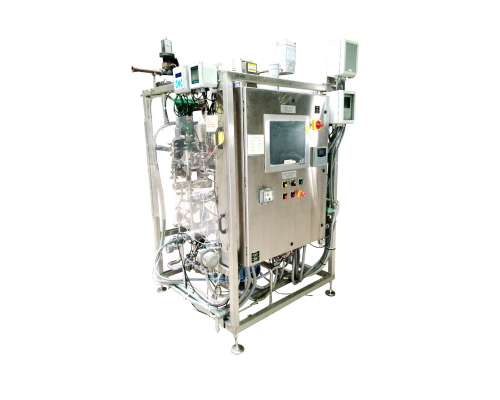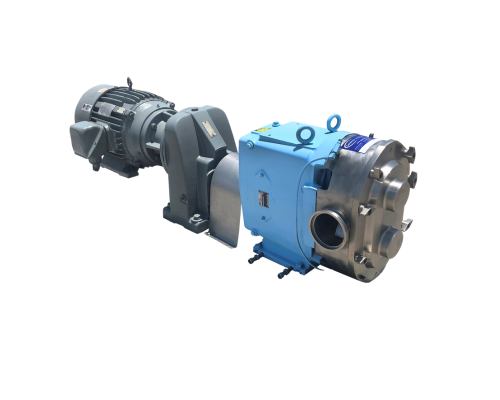La industria de generación de energía requiere un control preciso de las temperaturas y presiones para garantizar la eficiencia, la confiabilidad y el cumplimiento de las normas ambientales. Los intercoolers y subcoolers desempeñan un papel fundamental en la optimización de los procesos termodinámicos, el enfriamiento de fluidos y gases, y permiten el funcionamiento eficiente de turbinas y compresores. A continuación, exploramos sus aplicaciones en diversos aspectos de la generación de energía.
Imagen de Genemco
Enlace a Intercoolers y subcoolers

1. Centrales eléctricas con turbinas de gas
Las turbinas de gas se utilizan ampliamente en la generación de energía debido a su capacidad de producir altos niveles de potencia de manera eficiente. Los intercoolers se utilizan en sistemas de compresión de múltiples etapas dentro de las turbinas de gas para mejorar la eficiencia general y reducir la tensión operativa. Los beneficios clave incluyen:
- Eficiencia mejorada: Enfriar el aire comprimido entre etapas reduce el trabajo requerido por los compresores, mejorando la eficiencia térmica de la turbina.
- Mayor potencia de salida: al reducir la temperatura del aire aumenta su densidad, lo que permite que llegue más oxígeno a la cámara de combustión para una mejor combustión.
- Mayor vida útil del equipo: reducir el estrés térmico en los componentes de la turbina evita el sobrecalentamiento y extiende la vida útil.
2. Centrales eléctricas de ciclo combinado
Las centrales eléctricas de ciclo combinado (CCPP) combinan turbinas de gas y turbinas de vapor para lograr una mayor eficiencia al utilizar el calor residual de las turbinas de gas para generar vapor. Los subenfriadores se utilizan en el ciclo de vapor para mejorar la eficiencia al enfriar el vapor condensado a una temperatura más baja antes de reintroducirlo en la caldera o el generador de vapor de recuperación de calor (HRSG). Sus funciones incluyen:
- Recuperación de calor mejorada: al enfriar el condensado, los subenfriadores mejoran la eficiencia termodinámica del ciclo de vapor.
- Pérdidas térmicas minimizadas: reducir las temperaturas del vapor ayuda a recuperar la máxima energía del calor residual.
3. Almacenamiento de energía mediante aire comprimido (CAES)
Los sistemas CAES almacenan energía comprimiendo el aire y liberándolo posteriormente para impulsar turbinas. Los intercoolers se utilizan para enfriar el aire durante el proceso de compresión, mientras que los subcoolers se pueden utilizar para condensar y enfriar el aire antes del almacenamiento. Los beneficios de los CAES incluyen:
- Volumen de almacenamiento reducido: al enfriar el aire comprimido se reduce su volumen, lo que hace que el almacenamiento sea más eficiente.
- Eficiencia de ciclo mejorada: el enfriamiento entre las etapas de compresión reduce el consumo de energía.
- Mayor confiabilidad del equipo: la reducción de la temperatura del aire reduce el desgaste de los compresores y los tanques de almacenamiento.
4. Centrales nucleares
En las centrales nucleares, los intercoolers y subcoolers respaldan sistemas auxiliares como los circuladores de gas, que mueven gases refrigerantes (por ejemplo, helio o dióxido de carbono) a través del núcleo del reactor. Las aplicaciones incluyen:
- Enfriamiento de gas en reactores de alta temperatura: los enfriadores intermedios enfrían el gas entre las etapas de compresión, manteniendo temperaturas operativas seguras.
- Enfriamiento de condensado en ciclos de vapor: Los subenfriadores en el sistema de condensado mejoran la eficiencia al reducir la temperatura del agua de retorno antes de su reintroducción al generador de vapor.
5. Sistemas de energía renovable
Los intercoolers y subcoolers se integran cada vez más en los sistemas de energía renovable para mejorar la eficiencia y la confiabilidad energética. Algunos ejemplos incluyen:
- Plantas de energía geotérmica: Los intercoolers y subcoolers ayudan en el manejo del vapor y la salmuera geotérmica, enfriando fluidos para mejorar la extracción de energía y el rendimiento del sistema.
- Generación de energía a partir de hidrógeno: en los sistemas basados en hidrógeno, los intercoolers enfrían el gas hidrógeno comprimido para su almacenamiento o combustión, lo que garantiza operaciones seguras y eficientes.
6. Cogeneración y calefacción urbana
Las plantas de cogeneración, que producen tanto electricidad como calor, utilizan intercoolers y subcoolers para controlar las temperaturas en los sistemas combinados de calor y electricidad (CHP). Estos componentes:
- Mejorar la eficiencia: los subenfriadores enfrían el agua utilizada para la calefacción urbana, optimizando la transferencia y distribución del calor.
- Mejore la versatilidad: los intercoolers en los sistemas de cogeneración permiten una mejor integración con las redes de calefacción industriales y residenciales.
7. Sistemas de recuperación de calor residual
Los sistemas de recuperación de calor residual en las centrales eléctricas suelen utilizar subenfriadores para enfriar los gases de escape y recuperar el calor residual. Esta energía recuperada se utiliza para precalentar el agua o el aire, lo que reduce el consumo de combustible y mejora la eficiencia de la planta.
Imagen de Genemco
Enlace a Intercoolers y subcoolers

Los intercoolers y subcoolers son esenciales en la industria de generación de energía, ya que respaldan una amplia gama de sistemas, desde turbinas de gas y plantas de ciclo combinado hasta configuraciones de energía renovable y cogeneración. Al optimizar el control de temperatura, estos dispositivos mejoran la eficiencia energética, reducen las emisiones y extienden la vida útil de los equipos. A medida que evoluciona la industria de generación de energía, los intercoolers y subcoolers seguirán siendo fundamentales para satisfacer la creciente demanda de soluciones energéticas sostenibles y confiables.















